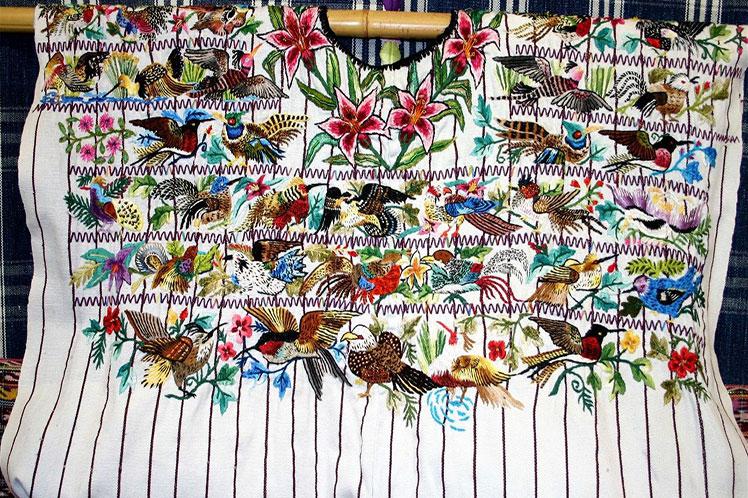Escáner spoke with Any Pascual, her real name, the one she has almost lost, very consciously, to accentuate the Mayan blood that runs through her veins and the roots of Santa Eulalia, Huehuetenango.
Although she has lived in the capital city since she was very young, she has never refused to speak Q'anjob'al, her mother tongue, nor to wear the clothing of her people and of other Guatemalans on a daily basis because she considers that "there is no customs and ancestral traditions can be left to die”.
From her social network and the radio qanjobalgt.com, she spreads them to the young generations with videos, photos, dances and sounds.
A nurse by profession, an announcer and currently a Communications graduate student with an emphasis in Journalism, Qanjobalita does not hesitate to state that wearing her typical costume means "carrying an ancient history, which is intertwined with thread through the fabrics of the figures. ”.
“It is ancestral knowledge, and I do it with pride because she identifies me as a woman of Mayan descent,” she told Escáner.
“Since I was little, she said, my mother put my clothes on, she never bought me pants or dresses, I only wore the school uniform, but I only came from studying and changed. That's how I grew up and although she doesn't believe it, I even use it to sleep, I don't get used to pajamas”.
In the case of my town, it is a white güipil that symbolizes purity; On his neck he wears colored braids (the rainbow) and he also wears some ornaments in the form of volcanoes for the different hills and volcanoes that surround the Q'anjob'al town.
The red cut alludes to the sunrise, the blood that runs through our veins, and is held up with a red or other colored band, while the hair is braided with sheep's wool or some colored red ribbon, she explains.
"The ceremonial dress is the same as daily, but we add a long güipil, either worn on top or worn on the head to protect us from the heat or the rain."
I have two daughters to whom I instill the use of our clothing so that it does not get lost, so our culture will never die, she says confidently.
RESISTANCE CANVAS
Centuries of discrimination and racism against the indigenous population by successive governments of Guatemala, lead some women to stop wearing their typical costumes to have the acceptance of a society that deep down continues to point them out, even if they dress in "fashion".

So know you are going to love this... https://t.co/RMrrdnyCRn
— Sj Kyte Sun Jul 04 20:45:49 +0000 2021
But others, like the Mayan Kaqchikel actress María Mercedes Coroy, cling to their roots to show the world the wisdom of the weaver grandmothers.
According to Coroy, "the Mayan fabrics are those canvases that become our clothing and that claim resistance and the struggle to have our own identity, our constant struggle," and he says it appropriately, since he has suffered firsthand the weight of the stereotypes.
With international awards for films such as La Llorona, also from Guatemala, Jayro Bustamante, the 27-year-old recently felt alluded to in the comments made on a youtuber program about how leading actresses should dress at public events, read the red carpet.
Such an unfortunate opinion led the protagonist of the multi-award-winning film Ixcanul to publicly state: “We are not, at any time, as mentioned, people who can be taken and dressed in a certain way. We remind them, we have our own criteria and we make our own decisions.”
“I have been invited to red carpets with the great opportunity to represent my country around the world. When I do it, I like to think that I represent an entire country, not just a part of it,” she stressed.
The choice of what I will use is my decision and I have the support of my work team that is increasingly committed to my vision, she wrote on her Facebook account.
Coroy said that in Germany she felt proud to wear the costume of Santa María de Jesús, where she is from, and later she grew the idea of sharing the beauty of other outfits that accompany her internationally, such as that of Xela, Cobán, Patzún , Quiche or Palin.
"More than an outfit to look good or be fashionable, our clothing is part of our history, the legacy of our ancestors through time," she said.
That is why he persists in continuing to break barriers: it is difficult, he assures, but not impossible. "It is the clear example that after so many struggles we continue to emerge... like our fabrics."
arb/mmc
*This work had the collaboration of the chief editor Luisa María González, the editor Amelia Roque, the head of the Central-South American Editorial Office Alain Valdés, and the webmaster Diego Hernández.
Without mining or Portezuelo, a company that produces wine is born in Malargüe
Goodbye to Carlos Marín: this is the heritage and fortune left by the singer of Il Divo
Record of women affiliated with Social Security, but temporary and with low salaries
Ceviche to Recoleta and croissants for officials: the bet of the workers of Villa 31 to sell outside the neighborhood